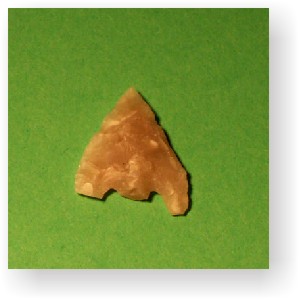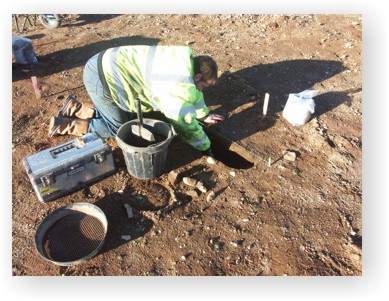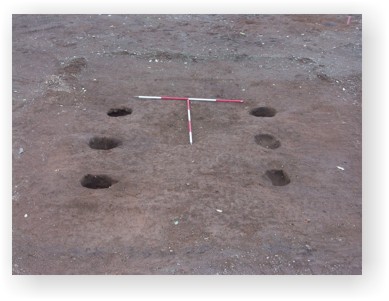Lanton Quarry
Bronze Age (2,400- 700 BC):
A barbed and tanged flint arrowhead found during fieldwalking |
The Bronze Age is the name given to the period when metalworking was first introduced into Britain and farming became more intensive and widespread.
Some of the stone artefacts that were found during the fieldwalking date to the earliest Bronze Age period. A barbed and tanged arrowhead was amongst the most exciting of the finds. A fine pottery drinking vessel associated with the first metal users known as a 'Beaker' was found on the site buried within a pit, although only the pot base has survived. It has fine decoration all over its surface and may have been involved in rituals associated with the production of metal.
The foundations of three Bronze Age roundhouses have been found at the quarry, two of which have produced radiocarbon dates that place them in the Middle Bronze Age around 1500BC. They had central hearths and rubbish pits associated with them, the latter containing broken pot fragments of 'Flat-Rimmed Ware' vessels.
Associated wuth the roundhouses were distinctive six-post structures. The postholes were deep and of substantial size, suggesting that they supported a tall structure but not one large enough to live in. It is thought that these are the post-hole remains of raised granneries kept off the ground to safeguard grain from vermin and damp.
Pottery dating from the Bronze Age period was quite common across the excavated areas of Lanton Quarry. The pottery tends to be quite rough with no decoration and was used primarily as a domestic ceramic for storing, cooking and eating.
A team of archaeologists excavating one of the Bronze Age house at Lanton Quarry |
A Bronze Age posthole under excavation |
One of the six-posthole buildings which may be some form of raised granary |
The posthole remains of a Bronze Age round house showing the porch beyond the red and white ranging poles looking south-east |
| Neolithic | Bronze Age | Medieval |





